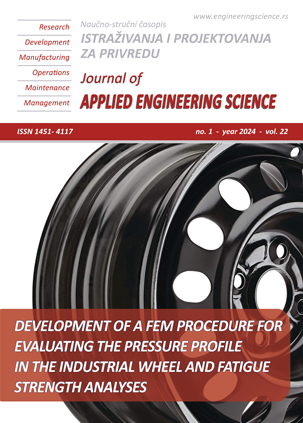USING VIKOR AND RSM-DA IN THE OPTIMIZATION OF DRY TURNING OF 9XC STEEL
Abstract
Dry turning is an effective method for reducing the production costs and environmental impact of machining processes. In this study, the effect of cutting speed (Vc), feed rate (fz), and depth of cut (ap) on the surface roughness (Ra) and material removal rate (MRR) of 9XC steel during dry turning was investigated. A Box-Behnken experimental design was employed to analyze the main effects and interaction effects of these cutting parameters. In this research, the combining Response Surface Methodology - Desirability Approach (RSM-DA) and VIseKriterijumska Optimizacija I Kompromisno Resenje (VIKOR) method were both employed for solving multiple objective optimization problems, and their performance was compared. The results from both methods can be assessed based on their ability to identify the optimal set of parameters that simultaneously optimize surface quality and production rate, as well as their computational efficiency and ease of implementation. Both RSM-DA and VIKOR have been found effective for solving multi-objective optimization problems, such as optimizing cutting parameters in dry turning. While RSM-DA is a statistical tool that combines multiple objectives into a single function, VIKOR is a decision-making method that ranks alternatives based on multiple criteria. The choice of which method to use depends on the specific requirements of the problem and the availability of resources for implementation. The research results show that both VIKOR and RSM-DA are suitable for solving the multi-objective optimization problem of the turning process. According to the VIKOR method, the optimum cutting conditions were found to be a cutting speed Vc of 120 m/min, a depth of cut ap of 0.1 mm a feed rate fz of 0.06 mm/rev, and, which resulted in a surface roughness of 0.209 um and a material removal rate of 0.72 cm3/min. Meanwhile, RSM-DA predicts the optimal Ra and MRR values of 0.254 um and 3.36 cm3/min, respectively; corresponding to the Vc of 180m/min, fz of 0.06mm/rev and ap of 0.3mm; That means, the increasing the value of surface roughness by 21.5% will increase the MRR by 366.7%. The findings of this study can provide guidance for selecting the appropriate cutting parameters for dry turning of 9XC steel to achieve desired surface roughness Ra and material removal rate MRR in the specific case.
References
S. Kalpakjian, Manufacturing Engineering & Technology, 7th ed. Pearson, 2013.
S. Subbiah, Science of machining. 2015. doi: 10.1007/978-1-4471-4670-4_1.
G. S. Goindi and P. Sarkar, “Dry machining: A step towards sustainable machining – Challenges and future directions,” J. Clean. Prod., vol. 165, pp. 1557–1571, 2017, doi: https://doi.org/10.1016/j.jclepro.2017.07.235.
U. S. Dixit, D. K. Sarma, and J. P. Davim, “Dry machining,” SpringerBriefs Appl. Sci. Technol., no. 9781461423072, pp. 19–28, 2012, doi: 10.1007/978-1-4614-2308-9_3.
H. P. Zhang, Q. Y. Zhang, Y. Ren, T. Shay, and G. L. Liu, “Simulation and Experiments on Cutting Forces and Cutting Temperature in High Speed Milling of 300M Steel under CMQL and Dry Conditions,” Int. J. Precis. Eng. Manuf., vol. 19, no. 8, pp. 1245–1251, 2018, doi: 10.1007/s12541-018-0147-3.
G. T. Smith, Cutting Tool Technology: Industrial Handbook. Springer, 2008.
A. Khatri and M. P. Jahan, “Investigating tool wear mechanisms in machining of Ti-6Al-4V in flood coolant, dry and MQL conditions,” in Procedia Manufacturing, 2018. doi: 10.1016/j.promfg.2018.07.051.
W. Ze, D. Jianxin, C. Yang, X. Youqiang, and Z. Jun, “Performance of the self-lubricating textured tools in dry cutting of Ti-6Al-4V,” Int. J. Adv. Manuf. Technol., vol. 62, no. 9–12, pp. 943–951, 2012, doi: 10.1007/s00170-011-3853-x.
N.-T. Nguyen, V. T. Nguyen, D. Hoang Tien, and D. T. Do, “Multi-Objective Optimization of Turning Process Using a Combination of Taguchi and Vikor Methods,” J. Appl. Eng. Sci., no. May, pp. 1–6, 2021, doi: 10.5937/jaes0-29654.
N. Qian, Y. Fu, F. Jiang, W. Ding, J. Zhang, and J. Xu, “CBN grain wear during eco-benign grinding of nickel-based superalloy with oscillating heat pipe abrasive wheel,” Ceram. Int., vol. 48, no. 7, pp. 9692–9701, 2022, doi: 10.1016/j.ceramint.2021.12.170.
G.-H. Tzeng and J.-J. Huang, “TOPSIS and VIKOR,” Mult. Attrib. Decis. Mak., pp. 83–94, 2011, doi: 10.1201/b11032-9.
V. H. Pham, T. D. Nguyen, V. T. Le, and D. H. Tien, “Optimization of cutting parameters in MQL flat surface milling of SKD11 steel.”
V. T. Le Van-Canh Nguyen, Thuy Duong Nguyen, “Optimization of sustainable milling of SKD11 steel under minimum quantity lubrication,” Proc IMechE Part E J Process Mech. Eng., vol. 1, no. 10, 2022, doi: 10.1177/09544089221110978.

